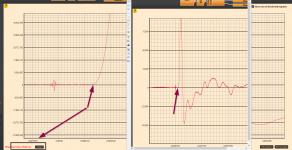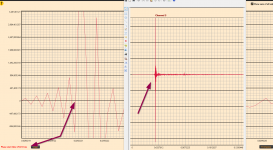Not a good idea if your tweeter has an uneven impedance curve.
144 dB is not enough?
1. True. Plus you lose efficiency. Though some tweeters may like it, more close to current drive.
2. Not really. Sometimes, I have volume at -60 dB. So I have 14 bits left. I would like 2 or 4 more bits.
2. Not really. Sometimes, I have volume at -60 dB. So I have 14 bits left. I would like 2 or 4 more bits.
If you have volume at -60 dB, you are playing really quietly (or have the gain structure totally wrong). At those volumes, what is the noise floor of your listening room? I am pretty sure it isn't 80 dB below your listening level...
2. Not really. Sometimes, I have volume at -60 dB. So I have 14 bits left. I would like 2 or 4 more bits.
Doesn't the theory of setting the gain structure so that the amps amplify more (you say, because it sounds better) then cause you to have lower quality digital output at low listening?
Perhaps you need more of a compromise on the theory of how you like the amp gain set versus ditigal attenuation.
Is there a way to set DAC output voltage with the DSP/DAC ? Perhaps the error at low level voltage output isn't good enough for 14 bit anyway?
A lot to balance to get gain structure right, (although arguably only the amp has a gain to be a structure), including the A/D side.
This is something a studio engineer would take a long time to get right and settle on (should they be allowed time) whilst the sense of plug and play for home DIY active/DSP doesn't always highlight the tweaking needed for max resolution.
Doesn't the theory of setting the gain structure so that the amps amplify more (you say, because it sounds better) then cause you to have lower quality digital output at low listening?
Perhaps you need more of a compromise on the theory of how you like the amp gain set versus ditigal attenuation.
Is there a way to set DAC output voltage with the DSP/DAC ? Perhaps the error at low level voltage output isn't good enough for 14 bit anyway?
You need to separate input gain from output gain. I proposed to ensure sufficient input gain to fill the 24 bits (or use digital in). This will ensure that the biquads run with maximal resolution. Reducing input level will never give benefits over reducing output level, unless you are at clip level.
Next, the output gain should be in a range that not too much attenuation is required at quiet listening, but also that loud listening is still possible. I removed Rg thus reduced gain a factor 4.67. Also I use a 2,2 ohm series resistor with the tweeter, reducing its level a few dB more. These changes made clearly audible improvements.
I could reduce gain further in my setup, but this would involve bigger circuit changes and remove system headroom. I am also pretty satisfied with sound, so no need for now. I only wonder whether 32 bit in to DAC would bring an audible benefit. You would assume they add a 32 bit input in the DAC for a reason, or is it only marketing? At least it could improve resolution in the oversampling filter.
That is when I play really quiet. Normal listening is -42..30 dB volume. By the way: I have quite some boosting filters which raise the level again.If you have volume at -60 dB, you are playing really quietly (or have the gain structure totally wrong). At those volumes, what is the noise floor of your listening room? I am pretty sure it isn't 80 dB below your listening level...
Indeed, there will be noise in the room. Though ears are pretty good at locating where sound comes from...
I only wonder whether 32 bit in to DAC would bring an audible benefit.
No. It is good to remember that pretty much all commercial recordings have less than 16 bits of range, and the same goes for listening rooms.
You would assume they add a 32 bit input in the DAC for a reason, or is it only marketing? At least it could improve resolution in the oversampling filter.
Marketing. "More must be better". In many cases it is actually 32-bit floating point which only has 24-bit resolution anyway.
In which case, it's literally true that it's 32 bit floating point, and honest to give that as a specification. That it's providing 24-bit resolution by being 32-bit float, again is positive and necessary for 24 bit audio.
The fault is then with the user in confusing 32 bit float with 32 bit resolution... So not particularly cynical marketting, but just not bothering to educate those who are thinking it means something else. Let the customer beleive what they want.. they've simply provided honest specs.
The fault is then with the user in confusing 32 bit float with 32 bit resolution... So not particularly cynical marketting, but just not bothering to educate those who are thinking it means something else. Let the customer beleive what they want.. they've simply provided honest specs.
For low volumes with a JBL2226H + BMS 4594HE (97db woofer sens) and single from a analog preamp (volume control and input selection) would you go with the 123 or the 253 models?
FA123 has at least 20RMS on 8Ohms (NC122MP_02xx.pdf).
Do you think I need more or with a bigger amp Ill have to digitally have to reduce more power in the DSP/DAC? or the extra power might be good to have for the EQ/corrections? (I have never done DSP/Active EQ)
FA123 has at least 20RMS on 8Ohms (NC122MP_02xx.pdf).
Do you think I need more or with a bigger amp Ill have to digitally have to reduce more power in the DSP/DAC? or the extra power might be good to have for the EQ/corrections? (I have never done DSP/Active EQ)
Last edited:
This is with latest filters used.
Testing 693μs delay currently from the measurements above.
Your project file is incomplete, measurements channel 2 and 3 are missing and picture of your system wil be also nice.
Channel 2 is bridged for my 2way. Im using ch3 for tweeter.
Isn't the correct procedure like that:
Measure all unfiltered
Apply EQ and xo filters
Remeasure and configure delay after (?) applying above filters
Speaker is a little fugly atm
Measurements at post 1988 are after filters, without delay.
Isn't the correct procedure like that:
Measure all unfiltered
Apply EQ and xo filters
Remeasure and configure delay after (?) applying above filters
Speaker is a little fugly atm
Measurements at post 1988 are after filters, without delay.
Last edited:
No. It is good to remember that pretty much all commercial recordings have less than 16 bits of range, and the same goes for listening rooms.
Marketing. "More must be better". In many cases it is actually 32-bit floating point which only has 24-bit resolution anyway.
Could be, but you still need more than 16 bits in case of further DSP processing and especially digital volume control.
In the case of the AD4454 used in Fusion, it actually supports 32 bit linear input. I think the reason 24 bit is chosen lies in the DSP chip, as 24 bit input and output is supported there. Anyhow... Fusion still sounds pretty great...
Just wanna be sure I follow the correct process for delay on this FAST project, before installing the fusions on my main horn system.
Measure separate drivers with xo filters applied, zoom on the impulse screen like following pics, and subtract the first big impulse time?
Measuring at 20cm, iSEMcon mic + UMC22
Measure separate drivers with xo filters applied, zoom on the impulse screen like following pics, and subtract the first big impulse time?
Measuring at 20cm, iSEMcon mic + UMC22
Attachments
Could be, but you still need more than 16 bits in case of further DSP processing and especially digital volume control.
In the case of the AD4454 used in Fusion, it actually supports 32 bit linear input. I think the reason 24 bit is chosen lies in the DSP chip, as 24 bit input and output is supported there.
My point is that yes, you need more than 16 bits for processing and volume control. You don't need more than 24 bits for input and output.
Removed the Rg resistors today.
Definitely not a subtle difference.
Highly recommended to anyone wanting to void his warranty and risk his boards
how many db lower the amp is getting?
Removed the Rg resistors today.
Definitely not a subtle difference.
I would not expect a change in gain to be subtle.
- Home
- Amplifiers
- Class D
- The New Hypex Fusion Plate amps

